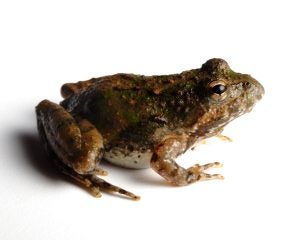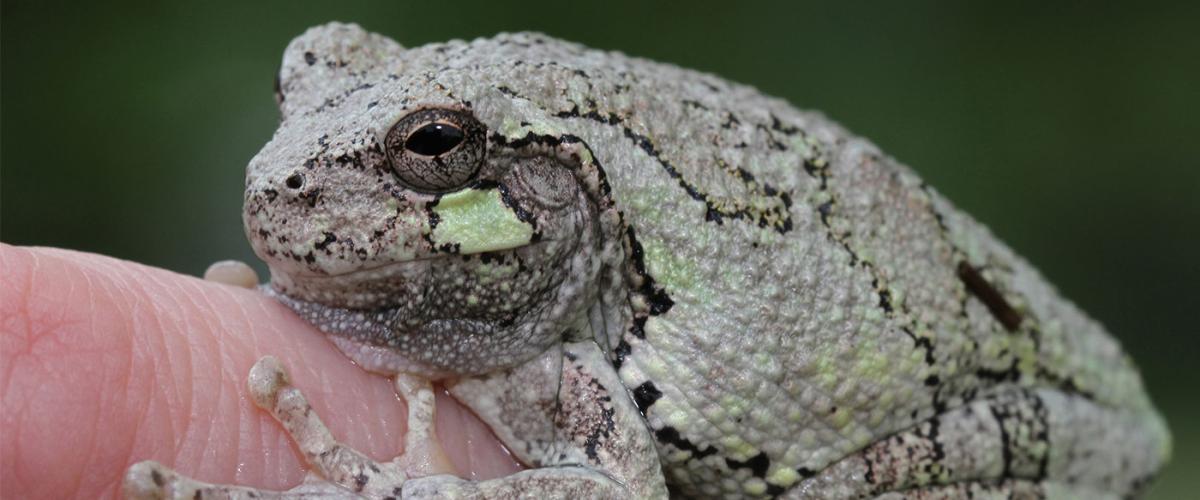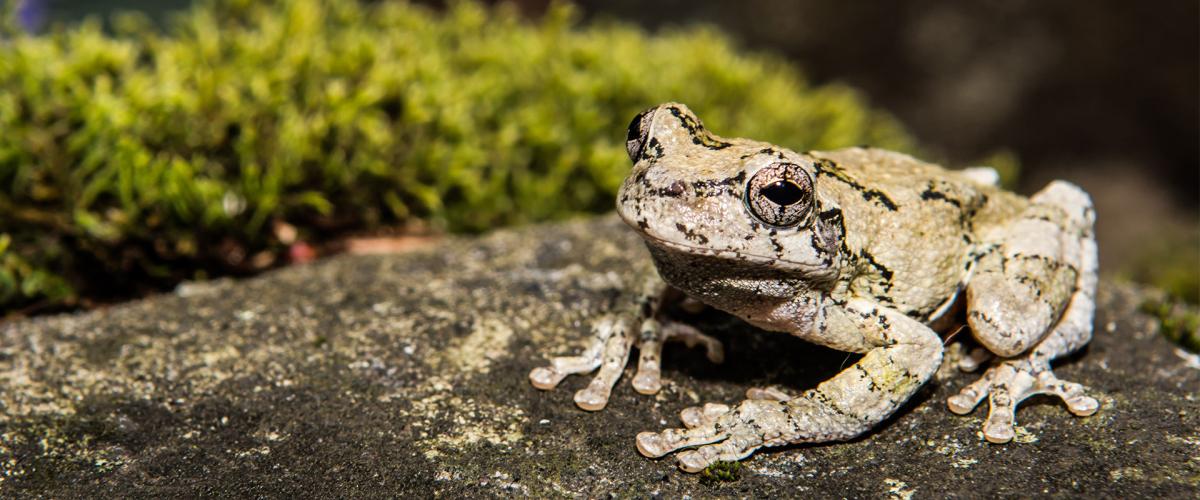 The cricket frog. Photo by Tim Krynak.
Man-made changes to the environment may be damaging the immune systems of a species of frog whose populations have drastically declined since the 1970s, according to a new study by researchers at Case Western Reserve University and the Holden Arboretum.
“These Blanchard’s cricket frogs have nearly gone extinct in their northern range, so we’re almost forensically trying to understand what happened,” said Mike Benard, a biology associate professor at Case Western Reserve. “This study suggests that changes we are making to the environment have the potential to make animals more susceptible to diseases and therefore may lead to population declines.”
Scientists found that habitat characteristics explained the differences in immune defense traits of frogs between populations. They found that the skin microbiomes—symbiotic bacterial and fungal communities on the skin—of frogs from disturbed sites, like residential and agricultural lands, were different from the skin microbiomes of frogs from more natural habitats. They also found natural peptide secretions—proteins frogs secrete from their skin that protect against pathogens—differed between frogs from different environments.
Both changes potentially alter the amphibian’s immune defense capabilities.
These findings and more are published in the journal Biological Conservation.
Research is increasingly showing that microbiomes in the gut and on the skin and antimicrobial peptides excreted by humans and other animals play important roles in fighting infection and disease.
“We’re seeing a lot of disease-related declines among amphibians, not to mention other groups of animals, such as bats plagued with white-nose syndrome and bees suffering from colony collapse disorder,” said Katherine Krynak, a postdoctoral scholar in Case Western Reserve’s Department of Biology and leader of the study. “This research shows that land use—farming or treating lawns with herbicides, pesticides and fertilizers—can influence traits that protect animals from disease.”
The cricket frog. Photo by Tim Krynak.
Man-made changes to the environment may be damaging the immune systems of a species of frog whose populations have drastically declined since the 1970s, according to a new study by researchers at Case Western Reserve University and the Holden Arboretum.
“These Blanchard’s cricket frogs have nearly gone extinct in their northern range, so we’re almost forensically trying to understand what happened,” said Mike Benard, a biology associate professor at Case Western Reserve. “This study suggests that changes we are making to the environment have the potential to make animals more susceptible to diseases and therefore may lead to population declines.”
Scientists found that habitat characteristics explained the differences in immune defense traits of frogs between populations. They found that the skin microbiomes—symbiotic bacterial and fungal communities on the skin—of frogs from disturbed sites, like residential and agricultural lands, were different from the skin microbiomes of frogs from more natural habitats. They also found natural peptide secretions—proteins frogs secrete from their skin that protect against pathogens—differed between frogs from different environments.
Both changes potentially alter the amphibian’s immune defense capabilities.
These findings and more are published in the journal Biological Conservation.
Research is increasingly showing that microbiomes in the gut and on the skin and antimicrobial peptides excreted by humans and other animals play important roles in fighting infection and disease.
“We’re seeing a lot of disease-related declines among amphibians, not to mention other groups of animals, such as bats plagued with white-nose syndrome and bees suffering from colony collapse disorder,” said Katherine Krynak, a postdoctoral scholar in Case Western Reserve’s Department of Biology and leader of the study. “This research shows that land use—farming or treating lawns with herbicides, pesticides and fertilizers—can influence traits that protect animals from disease.”
Land use may weaken amphibian’s capacity to fight infection and disease
 The cricket frog. Photo by Tim Krynak.
Man-made changes to the environment may be damaging the immune systems of a species of frog whose populations have drastically declined since the 1970s, according to a new study by researchers at Case Western Reserve University and the Holden Arboretum.
“These Blanchard’s cricket frogs have nearly gone extinct in their northern range, so we’re almost forensically trying to understand what happened,” said Mike Benard, a biology associate professor at Case Western Reserve. “This study suggests that changes we are making to the environment have the potential to make animals more susceptible to diseases and therefore may lead to population declines.”
Scientists found that habitat characteristics explained the differences in immune defense traits of frogs between populations. They found that the skin microbiomes—symbiotic bacterial and fungal communities on the skin—of frogs from disturbed sites, like residential and agricultural lands, were different from the skin microbiomes of frogs from more natural habitats. They also found natural peptide secretions—proteins frogs secrete from their skin that protect against pathogens—differed between frogs from different environments.
Both changes potentially alter the amphibian’s immune defense capabilities.
These findings and more are published in the journal Biological Conservation.
Research is increasingly showing that microbiomes in the gut and on the skin and antimicrobial peptides excreted by humans and other animals play important roles in fighting infection and disease.
“We’re seeing a lot of disease-related declines among amphibians, not to mention other groups of animals, such as bats plagued with white-nose syndrome and bees suffering from colony collapse disorder,” said Katherine Krynak, a postdoctoral scholar in Case Western Reserve’s Department of Biology and leader of the study. “This research shows that land use—farming or treating lawns with herbicides, pesticides and fertilizers—can influence traits that protect animals from disease.”
The cricket frog. Photo by Tim Krynak.
Man-made changes to the environment may be damaging the immune systems of a species of frog whose populations have drastically declined since the 1970s, according to a new study by researchers at Case Western Reserve University and the Holden Arboretum.
“These Blanchard’s cricket frogs have nearly gone extinct in their northern range, so we’re almost forensically trying to understand what happened,” said Mike Benard, a biology associate professor at Case Western Reserve. “This study suggests that changes we are making to the environment have the potential to make animals more susceptible to diseases and therefore may lead to population declines.”
Scientists found that habitat characteristics explained the differences in immune defense traits of frogs between populations. They found that the skin microbiomes—symbiotic bacterial and fungal communities on the skin—of frogs from disturbed sites, like residential and agricultural lands, were different from the skin microbiomes of frogs from more natural habitats. They also found natural peptide secretions—proteins frogs secrete from their skin that protect against pathogens—differed between frogs from different environments.
Both changes potentially alter the amphibian’s immune defense capabilities.
These findings and more are published in the journal Biological Conservation.
Research is increasingly showing that microbiomes in the gut and on the skin and antimicrobial peptides excreted by humans and other animals play important roles in fighting infection and disease.
“We’re seeing a lot of disease-related declines among amphibians, not to mention other groups of animals, such as bats plagued with white-nose syndrome and bees suffering from colony collapse disorder,” said Katherine Krynak, a postdoctoral scholar in Case Western Reserve’s Department of Biology and leader of the study. “This research shows that land use—farming or treating lawns with herbicides, pesticides and fertilizers—can influence traits that protect animals from disease.”




